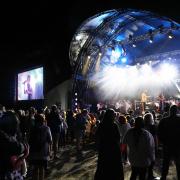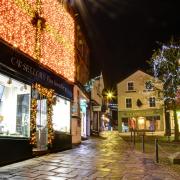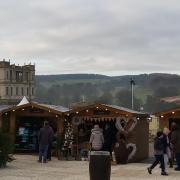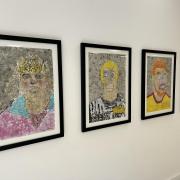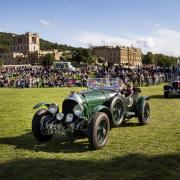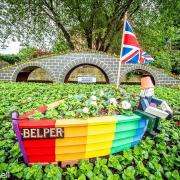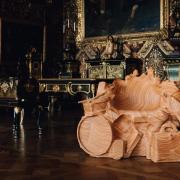Maxwell Craven has been fighting to preserve Derby’s heritage for more than 30 years

Maxwell Craven has been fighting to preserve Derby’s heritage for more than 30 years – going into battle to rescue the city’s historic buildings from the ravages of development.
He lost his first major battle – to save Derby’s early Victorian railway station – in the 1980s but, rather than being put off by the defeat, it stirred him to join more causes and he played a key part in saving the historic Shire Hall from disaster.
He says: ‘If you are going to fight for something, it has to be winnable and there has to be something worth winning. The railway station was worth the effort, even though we lost.
‘It was built in 1839, one of the earliest built in this country. It had been rebuilt three times but the original station was all still there. It had been neglected and was hit by a bomb in the Second World War but all was far from lost.

‘The story goes that Sir Peter Parker, chairman of the nationalised railways, came through with a Chinese delegation and had never been to Derby before. He walked through the gloomy station concourse and was so embarrassed he wanted it gone immediately.
‘But, sadly, he decided to knock the whole thing down, not preserve what was good about it. So we fought a battle to save it. We pointed out that underneath it was a fabulous station and that the original fascia could be restored and be wonderful.
‘The Civic Society architect was also a railway enthusiast and led the campaign but we couldn’t get it listed and the present station was built. A great shame really.’
Maxwell came to Derby in the 1970s to gain his teacher training certificate and stayed on in the city after being appointed education officer at Derby Museum.

He says: ‘I was always curious about local history but I only got really interested a few years later in when the museum said “you are going to be keeper of antiquities”. I quickly discovered that the job involved answering questions about Derby and giving lectures about local history. And, of course, you always ended up learning more as the feedback after was marvellous.
‘I also had the pleasure of knowing Roy Christian quite well and he taught me all the disreputable tales about Derby to regale people with – such as the brothel in St Mary’s Gate in the 18th century.
‘Gradually all this information built up and I had to do my professional qualification and I chose to write about the survival of town houses in Derby. I knocked off a dissertation and when it was finished the museum said “You may as well turn it into a book and we will sell it in the shop”. It sold amazingly well, even though it wasn’t written in a populist way.’
With all copies of the book selling out the publisher wanted more from Maxwell and he started on what became The Illustrated History of Derby, another good seller. Since then, Maxwell has gone on to write more than 20 books, including two volumes on Derbyshire Country Houses with Michael Stanley, which also sold out.

He also quickly became the go-to-man for individuals or groups seeking information on the city’s history. His job meant that he was expected to sit on the Derbyshire Archaeological Society, who in turn nominated him for the Derbyshire Historic Buildings Trust, and he soon found himself involved in most things that affected local heritage and conservation in the city.
He became involved in the Civic Society during the battle to save Derby Station in 1983/4. He says: ‘Because I could string a few words together, I was asked to produce the newsletter and I have been doing it ever since.’
That stirred Maxwell’s interest in conservation and battles to save Derby’s heritage from destruction and development.
He says: ‘That made me very unpopular with members of the elected council as we often took up cudgels, which didn’t always go down well.’ One battle he remembers was a fight against a plan for the Shire Hall in St Mary’s Gate, a Grade I listed building which had been abandoned for years and faced a potentially damaging development in the mid-1990s.

He says: ‘The county council owned the building but the city council wouldn’t serve a repairs notice on the authority despite its neglected state. Instead, a plan was put forward to knock down almost everything but the original 17th century building and we went into open warfare over that.
‘We had a wonderful meeting with planning officers and councillors where we explained that this was the building where the Pentrich Martyrs were tried and sent down, a major happening in national labour history. Not to mention the trial of the Silk Mill lock-out strikers. Not only did they not know, they really didn’t care.
‘But we managed to save both sides of the complex, which was brilliant.’
So has Derby looked after its heritage well or badly on the whole?

Maxwell says: ‘I actually think our historic buildings have survived better than in many places. The authorities still could have been kinder to the historic environment but it could have been a lot worse.
‘The biggest battles in the last 20 years have been more about stopping them putting up awful buildings to replace the ones they have knocked down.’
Derby has got things to be proud of though on the conservation side. ‘Such as the saving of St Helen’s House,’ says Maxwell. ‘The county council wouldn’t even release simple information about it they were so jumpy about the condition of the building at one stage. But when it came to the city council they had the wisdom to sell the lease to someone who could, and would, restore it. It was finished in 2013 to a terrific standard and a client was found for it. It’s a genuine success story and shows the way forward. If you have a problem building, get someone in who knows how to deal with them.
‘That’s what has been needed at Elvaston Castle for years.’

Of the modern buildings, Maxwell thinks that those which have been well designed and built will become the ones we cherish in the future. ‘The Jurys Inn is just a plastic tower,’ he says. ‘But some new buildings do have quality. We give an award each year at the Civic Society for the best new buildings and we gave one to the Council House, which is in essence new. That development has worked out well. The question is what we will think of things in two generations.
‘What we need to do is hold on to more old buildings, to adapt them. It makes sense to restore a Georgian or Victorian building that has been built solidly, rather than throwing up something new and cheap. It’s a point we keep making even though developers maintain it’s cheaper to knock something down and start again. It’s not, it’s just easier.’
Maxwell was awarded the MBE in 1999 for services to conservation. But he modestly says that he’s always needed help from others, not least his wife.
He says: ‘I couldn’t have done it without the support (and transport) provided for me by Carole, who has a terrific eye for nonsense and who serves with me on the Derby Conservation Area Advisory Committee.’







